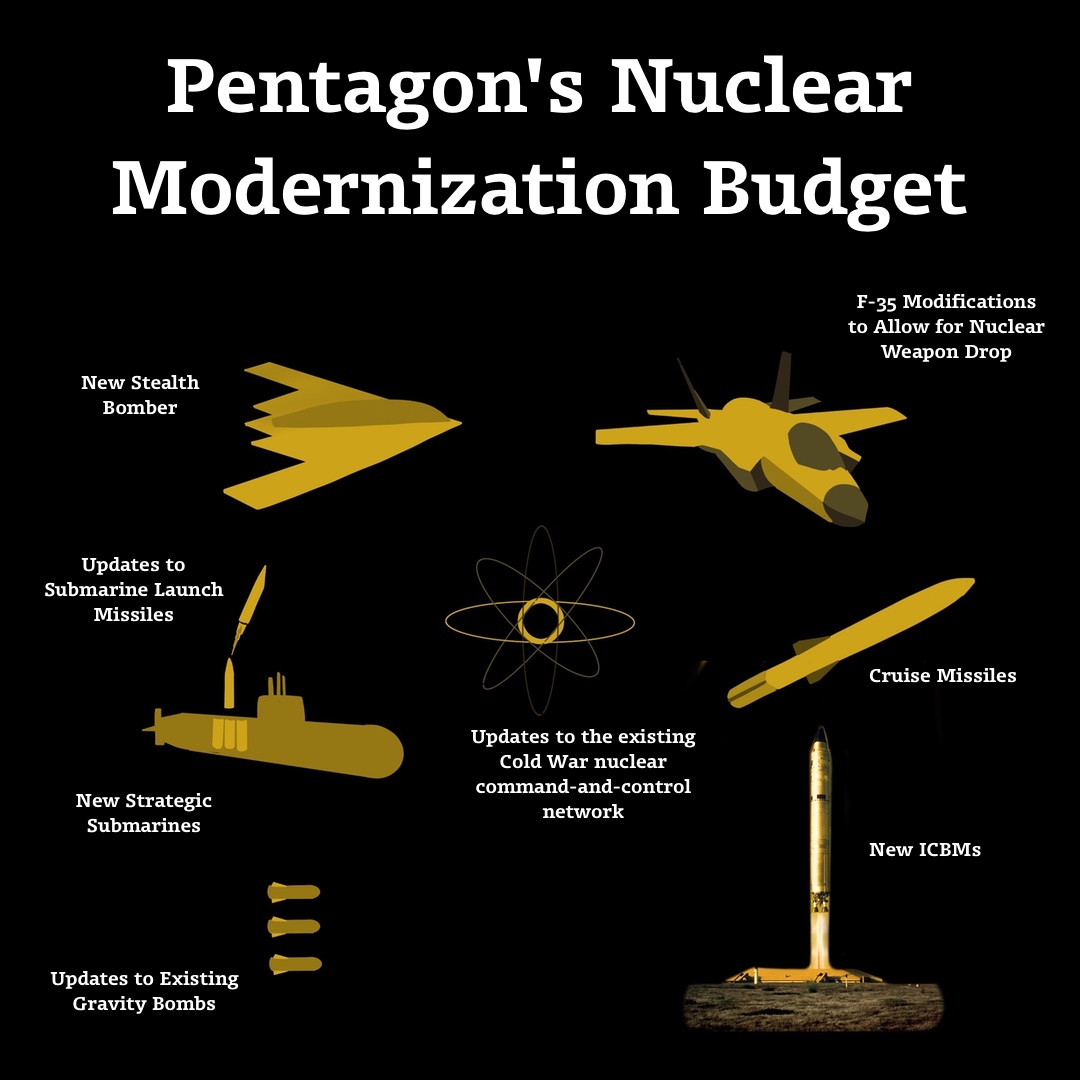
The Congressional Budget Office’s latest estimate is that U.S. nuclear forces will cost $634 billion over the next 10 years. DOD / Elizabeth Howe
Biden's Nuclear Spending Plans Just Got More Complicated
How much will Russia’s war on Ukraine change America's aging nuclear arsenal?
SPECIAL REPORT: Part I | Part 2 | Part 3
Anti-nuke activists have long suggested that America’s nuclear weapons are too costly as well as too dangerous. Now they’re finding common ground with military and security experts who say planned upgrades to the strategic arsenal would crowd out a host of other, more cost-effective, programs.
How much does it cost the United States to be a nuclear superpower? Is the cost actually prohibitive? And is any real change wanted or expected from the Biden administration?
The existing arsenal is aging. “Virtually every component of the U.S. nuclear arsenal is due for modernization,” wrote experts Todd Harrison and Evan Montgomery, at the nonpartisan Center for Strategic and Budgetary Assessments, seven years ago. Now, with the Biden administration largely continuing its predecessors’ plans to upgrade or replace intercontinental ballistic missiles, or ICBMs, ballistic-missile submarines, and long-range strategic bombers, the Pentagon is about to hit what has long been called the “bow wave,” military parlance for catching up to long-delayed costs that have been building up for years.
“Folks have talked over the years about the nuclear bow wave: It's here,” Gen. Charles Q. Brown, the Air Force chief of staff, said March 9 at a defense industry conference in Washington. “This is something that happens once a generation and it puts a squeeze on the Air Force as you look at fully funding nuclear capability. It does put a little squeeze on the conventional capability.”
The Congressional Budget Office’s latest estimate is that U.S. nuclear forces will cost $634 billion over the next 10 years. The Defense Department would spend about $405 billion on the delivery systems; the Energy Department, some $229 billion on the warheads. Over the next 30 years, the cost to maintain all of these new weapons could total $2 trillion, according to the Arms Control Association.
The Biden administration was expected to have released its first Nuclear Posture Review by now, however the timing remains unknown–and possibly on hold indefinitely. Nuclear community leaders in January said that a draft was already at or near President Joe Biden’s desk for consideration. Since that report first was written, the world has changed. Russian forces have invaded neighboring Ukraine and President Vladimir Putin has threatened to use Moscow’s nuclear weapons against NATO.
Before Putin’s invasion, the Arms Control Association predicted the posture review would “retain the existing policy, ensuring that debate would center around low-hanging fruit” such as a new sea-launched cruise missile or a low-yield submarine-launched Trident missile.
Now, some nuclear policy leaders, including Rep. Doug Lamborn, R-Colo., the top Republican on the House Armed Services Subcommittee on Strategic Forces, are using Russia’s war to call on the Biden administration to pivot away from previous arms-reduction efforts and “recommit to a strengthened nuclear deterrence posture”—meaning continue to increase spending to update the arsenal.
But it is difficult to discern how much the Pentagon is spending on nuclear weapons right now. Money is spread across several budget accounts, and some is classified work hidden from public view.
The Pentagon considers eight projects part of its nuclear modernization budget: new ICBMs, cruise missiles, updates to submarine-launched missiles, a new stealth bomber, new strategic submarines, updates to existing gravity bombs, modifications to the F-35 fighter jet that allow it to drop nuclear weapons, and updates to the existing Cold War nuclear command-and-control network. Since 2013, Congress has approved about $67 billion for those, according to Forecast International, a data analysis firm owned by Defense One’s parent company. In fiscal 2021, the funding totaled $13 billion, or about 1.8 percent of the Pentagon’s $704 billion budget.

Understanding there are politics that accompany nuclear spending, Biden administration officials already had signaled they know modernization costs are sensitive and will be limited. “Recapitalizing the nuclear platforms and delivery systems and associated support systems will require significant investment over the next 20 years,” Biden administration officials wrote in their first budget proposal sent to Congress last year. “The amount expended to recapitalize the nuclear enterprise is not anticipated to exceed 7 percent of the Department’s budget during that period.”
Since 2013, through Democratic and Republican majorities and administrations, Congress has approved nearly $70 billion for what the Pentagon identified as its nuclear efforts. There’s uniform consensus that costs related to ICBMs, sub-launced missiles, cruise missiles, gravity bombs, and strategic submarines all count toward the nuclear total. But from there the debate begins. The true cost is likely much higher, as additional funds for nuclear weapons and delivery systems are classified or embedded within other projects. And tens of billions of dollars more fund the Energy Department’s National Nuclear Security Administration, which maintains the military’s nuclear warheads and runs federal laboratories.
“There are a lot of subjective assumptions that have to go into any cost estimate like this,” said Harrison, now director of defense budget analysis at the Center for Strategic and International Studies, or CSIS.
Take the Air Force’s new stealth bomber, the B-21. Eventually, the aircraft will be able to carry nuclear weapons, but like its predecessor, the iconic bat-winged B-2, it will also carry conventional, or non-nuclear, weapons. How much of the $90 billion to develop and buy 100 B-21s should count as nuclear costs?
The United States also maintains many other so-called “dual-capable” warplanes, including the F-35 stealth fighter, and F-16 and F-15 fighters. The Pentagon is factoring the costs of certifying the F-35 to drop gravity bombs into its nuclear spending projections, but not the total cost of the program to develop and buid F-35s, which has origins as far back as the 1980s
The same accounting problem applies to command-and-control systems, structures, and personnel. Should those costs count?
In 2019, the Air Force began requesting money for a special “nuclear command and control” budget account. Those funds cover the costs of special satellites, computers, and special networks needed to order a nuclear strike.
Then there’s missile defense, a network of early-warning radars and satellites that help guard the United States from nuclear, and non-nuclear weapons. For that total expense, the CBO counts the B-21 bomber, new jet engines for the Cold War-era B-52s, the security helicopters to protect missile fields in Alaska and California, and the early-warning satellites. It doesn’t count the early-warning radars, though.
Like all military projects, once money ends up in the federal budget, it’s difficult to remove. Each weapons project gains a constituency for the jobs they produce across congressional districts. Defense spending experts often say the best time to kill a Pentagon weapons program is before it begins. They apply the same adage to nuclear modernization on the whole.
“The biggest chance that the arms control community had to reduce nuclear weapons [and] nuclear delivery vehicles was in the Obama administration,” Harrison said. “Ultimately, President Obama didn't do it because he thought it was a higher priority to get New START ratified by the Senate and that was the deal he made with the devil.”
In other words, instead of beginning to rid the world of nuclear weapons as hoped, the Obama administration committed to recapitalizing the nuclear triad in exchange for getting Senate Republicans to support the arms treaty with Russia.
“To get New START ratified, he had to commit [to] and he actually followed through on recapitalizing all the legs of the nuclear triad,” Harrison said. “Once that deal was made and those recap programs were put into motion, the inertia has been too great to trim it back. Now that we've gotten this far into a lot of these programs, they're actually aren't good options.”
Take for instance the Cold War-era Minuteman III ICBM, which is supposed to be replaced by the Ground Based Strategic Deterrence missile, known as GBSD, both built by Northrop Grumman. In 2017, Harrison offered options for replacing the Minuteman III. But the range of options have changed already.
“There actually aren’t good options, you know, for any anything other than the program of record at this point, because we've expended so much of our supply of Minuteman III missiles through the test program that we have to have a replacement missile, because we're using up all the missile bodies,” he said, in recent interview with Defense One. Re-coreing the missiles is not a good option anymore. It would have been five years ago [or] 10 years ago, but not now.”
The Federation for American Scientists, as recently as last year, disagreed and said options do remain, such as buying fewer GBSD missiles, updating the current Minuteman III, or eliminating the ICBM leg of the triad.
“In fact, the Pentagon began to explore the possibility of significantly reducing the ICBM force throughout the New START force adjustment process, before ultimately deciding not to pursue them, in part due to pressure from the Senate ICBM Coalition,” the report states. That coalition has five Republicans and one Democrat, Sen. Jon Tester of Montana, home of Malmstrom Air Force Base, an ICBM base.
The new nuclear sea-launched cruise missile, called SLCM-N, could certainly be the one project cut, as could the low-yield submarine-launched missile. The Navy has already moved to stop funding the the sea-launched cruise missilet. Cutting the project would save about $10 billion over the next decade, according to the Congressional Budget Office estimate.
“Abandoning development of this new nuclear weapon should be an easy choice,” Monica Montgomery and Kingston Reif wrote in Defense One last year. Reif is now the deputy assistant secretary of defense for threat reduction and arms control at the Pentagon. But, again, that was written long before Russia invaded Ukraine.
Nuclear arms reductions beyond those projects is unlikely, especially given Putin’s threats of nuclear war, said Jack Weinstein, a Boston University professor and a retired lieutenant general who spent the majority of his career in the Air Force’s nuclear community.
“The question on the need to modernize the nuclear triad surrounds one basic question, what is normal Russian behavior? The Russian Federation of 1995 or 2022? The Russia of 1995 was an aberration,” Weinstein said. “While nuclear isn’t the panacea to peace, a strong, modernized nuclear Triad is essential to U.S. national security.”





